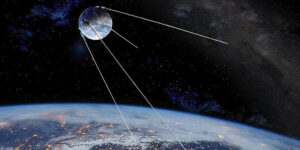On October 4, 1957, the world was forever changed with the launch of Sputnik 1, the first artificial satellite, by the Soviet Union. This historic event marked the inauguration of the space age and heightened the competition between the United States and the U.S.S.R. during the Cold War. Sputnik’s successful launch not only represented a significant technological achievement but also had profound implications for global politics, science, and society.
The Context of the Space Race
The launch of Sputnik occurred against the backdrop of the Cold War, a period characterized by intense rivalry between the United States and the Soviet Union. This ideological conflict was marked by competition in various domains, including military, technological, and cultural arenas.
In the years leading up to 1957, both superpowers were vying for supremacy, and advancements in science and technology became critical to national security and prestige. The idea of launching a satellite into orbit was not only a scientific goal but also a demonstration of technological prowess and military capability.
The Launch of Sputnik 1
Sputnik 1 was developed by the Soviet space program, led by engineers and scientists including Sergei Korolev, who is often referred to as the father of the Soviet space program. The satellite itself was a spherical metal capsule about 58 centimeters in diameter, equipped with four long antennae that transmitted radio signals back to Earth.
On October 4, 1957, Sputnik 1 was successfully launched from the Baikonur Cosmodrome in Kazakhstan. The satellite’s launch was a momentous event, as it was the first time a human-made object had entered Earth’s orbit. It transmitted beeping radio signals that were detectable worldwide, signifying its presence in the vastness of space.
Global Reactions
The launch of Sputnik 1 sent shockwaves around the globe, particularly in the United States. The American public and government officials were caught off guard by the Soviet achievement, which seemed to underscore the technological superiority of the U.S.S.R. at that moment.
In the immediate aftermath of the launch, there was widespread fear and anxiety in the United States. Many viewed Sputnik as a potential precursor to military capabilities, leading to concerns about the possibility of the Soviets launching missiles equipped with nuclear warheads. This perception fueled a sense of urgency in the U.S. to accelerate its own space program.
The Impact on the Space Race
The launch of Sputnik 1 marked the beginning of the space race, a fierce competition between the United States and the Soviet Union to achieve significant milestones in space exploration. In response to the Soviet achievement, the U.S. government took several actions to bolster its own space efforts.
One of the most significant steps was the establishment of the National Aeronautics and Space Administration (NASA) in July 1958, a direct response to the perceived threat posed by the Soviet space program. NASA’s mission was to coordinate and advance the U.S. space agenda, including the development of satellites, human spaceflight, and exploration.
The space race continued to escalate, leading to notable milestones such as the launch of Explorer 1, America’s first successful satellite, in January 1958. This intense competition eventually culminated in monumental achievements, including the first human in space, Yuri Gagarin, in April 1961, and the Apollo 11 mission, which landed humans on the Moon in July 1969.
Long-Term Implications
The launch of Sputnik 1 had profound implications beyond the immediate technological and military competition. It spurred advancements in science and technology, leading to significant developments in fields such as telecommunications, engineering, and materials science.
Moreover, the space race fostered a sense of unity and purpose within the United States, as citizens rallied around the goal of exploration and discovery. It also ignited public interest in science and mathematics, resulting in educational initiatives aimed at preparing future generations for careers in these fields.
The geopolitical ramifications of Sputnik’s launch also influenced international relations, as countries around the world recognized the importance of space exploration for national security and prestige. The competition between the superpowers extended into international alliances and partnerships, shaping the landscape of global politics for decades.
Conclusion
The launch of Sputnik 1 on October 4, 1957, marked the dawn of the space age and a significant turning point in the Cold War. It represented not only a remarkable technological achievement but also a catalyst for change in international relations, science, and education. Sputnik’s legacy endures as a testament to human ingenuity and the relentless pursuit of exploration, reminding us of the profound impact that advancements in technology can have on society and global dynamics. As we continue to explore the cosmos, we reflect on the foundational moments that paved the way for future generations of scientists and explorers.












What do you think?
It is nice to know your opinion. Leave a comment.